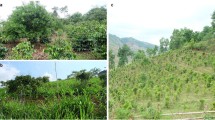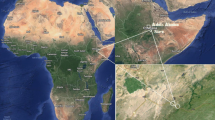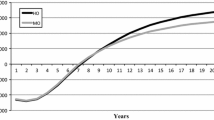Abstract
We analysed the economic viability of afforestation on marginal irrigated croplands in irrigated drylands of Uzbekistan. The revenues derived from a combination of diversified agricultural production, carbon sequestration, nitrogen fixation, and avoided irrigation water use were analysed considering uncertainty associated with on-farm activities such as crop production and short-rotation forestry. At the per hectare scale variability in land-use revenues would necessitate substantial increases in carbon prices for afforestation to be as profitable as crop cultivation on marginal lands, assuming an abundant irrigation water supply. In contrast, at the farm scale the analysis results revealed that afforestation can be attractive financially even without carbon payments due to farm production constraints, variable land-use returns, and the benefits of land-use diversification. Increased carbon prices would promote carbon sequestration by motivating farmers to plant high biomass producing tree species, but would have an ecosystem service trade-off by reducing the appeal of nitrogen-fixing species that are essential for nitrogen self-sufficiency of afforestation efforts. Given the modest irrigation needs of afforestation efforts compared to the cultivation of annual crops, tree plantations could become a primary income source for farms during periods of drought. Irrigation water saved from replacing crops with trees on marginal farmland would enhance the cultivation of commercial crops on productive lands, thus increasing farm income.








Similar content being viewed by others
References
Anderson JR (2003) Risk in rural development: challenges for managers and policy makers. Agric Syst 75(2–3):161–197
Anderson JR, Dillon JL (1992) Risk analysis in dryland farming systems, vol 2. Food and Agriculture Organization of the United Nations, Rome
Arrow KJ (1971) Essays in the theory of risk-bearing, vol 1. Markham Publishing Company, Chicago
Babu S, Rajasekaran B (1991) Agroforestry, attitude towards risk and nutrient availability: a case study of south Indian farming systems. Agrofor Syst 15(1):1–15. doi:10.1007/bf00046275
Bai ZG, Dent DL, Olsson L, Schaepman ME (2008) Proxy global assessment of land degradation. Soil Use Manag 24(3):223–234. doi:10.1111/j.1475-2743.2008.00169.x
Bateman IJ, Mace GM, Fezzi C, Atkinson G, Turner K (2011) Economic analysis for ecosystem service assessments. Environ Resourc Econ 48(2):177–218
Baumgärtner S, Quaas MF (2010) Managing increasing environmental risks through agrobiodiversity and agrienvironmental policies. Agric Econ 41(5):483–496. doi:10.1111/j.1574-0862.2010.00460.x
Benítez PC, Kuosmanen T, Olschewski R, Van Kooten CG (2006) Conservation payments under risk: a stochastic dominance approach. Am J Agric Econ 88(1):1–15. doi:10.1111/j.1467-8276.2006.00835.x
Berg E, Kramer J (2008) Policy options for risk management. In: Meuwissen MPM, van Asseldonk MAPM, Huirne RBM (eds) Income stabilisation in European agriculture. Wageningen Academic Publishers, Wageningen, pp 143–169
Berg E, Schmitz B (2008) Weather-based instruments in the context of whole-farm risk management. Agric Financ Rev 68(1):119–135
Bobojonov I, Aw-Hassan A (2014) Impacts of climate change on farm income security in Central Asia: an integrated modeling approach. Agric Ecosyst Environ 188:245–255
Cao S, Chen L, Shankman D, Wang C, Wang X, Zhang H (2011) Excessive reliance on afforestation in China’s arid and semi-arid regions: lessons in ecological restoration. Earth Sci Rev 104(4):240–245
Castro LM, Calvas B, Hildebrandt P, Knoke T (2013) Avoiding the loss of shade coffee plantations: how to derive conservation payments for risk-averse land-users. Agrofor Syst 1–17. doi:10.1007/s10457-012-9554-0
Chakraborty D (2010) Small holder’s carbon forestry project in Haryana India: issues and challenges. Mitig Adapt Strat Glob Chang 15(8):899–915
Chee YE (2004) An ecological perspective on the valuation of ecosystem services. Biol Conserv 120(4):549–565. doi:10.1016/j.biocon.2004.03.028
Costanza R, d’Arge R, de Groot R, Farber S, Grasso M, Hannon B, Limburg K, Naeem S, O’Neill RV, Paruelo J, Raskin RG, Sutton P, Van den Belt M (1997) The value of the world’s ecosystem services and natural capital. Nature 387:253–260. doi:10.1038/387253a0
Danso SKA, Bowen GD, Sanginga N (1992) Biological nitrogen fixation in trees in agro-ecosystems. Plant Soil 141(1):177–196. doi:10.1007/BF00011316
de Groot RS, Alkemade R, Braat L, Hein L, Willemen L (2010) Challenges in integrating the concept of ecosystem services and values in landscape planning, management and decision making. Ecol Complex 7(3):260–272. doi:10.1016/j.ecocom.2009.10.006
Dhakal B, Bigsby H, Cullen R (2012) Socioeconomic impacts of public forest policies on heterogeneous agricultural households. Environ Resour Econ 53(1):73–95. doi:10.1007/s10640-012-9548-4
Di Falco S, Perrings C (2005) Crop biodiversity, risk management and the implications of agricultural assistance. Ecol Econ 55(4):459–466. doi:10.1016/j.ecolecon.2004.12.005
Djanibekov N, Rudenko I, Lamers JPA, Bobojonov I (2010) Pros and cons of cotton production in Uzbekistan. In: Pinstrup-Andersen P, Cheng F (eds) Food Policy for Developing Countries: food production and supply policies, case study no 7–9. Cornell University Press, Ithaca, New York, pp 13–27
Djanibekov U, Khamzina A, Djanibekov N, Lamers JPA (2012) How attractive are short-term CDM forestations in arid regions? The case of irrigated croplands in Uzbekistan. For Policy Econ 21:108–117
Djanibekov N, Sommer R, Djanibekov U (2013a) Evaluation of effects of cotton policy changes on land and water use in Uzbekistan: application of a bio-economic farm model at the level of a water users association. Agric Syst 118:1–13
Djanibekov U, Djanibekov N, Khamzina A, Bhaduri A, Lamers JPA, Berg E (2013b) Impacts of innovative forestry land use on rural livelihood in a bimodal agricultural system in irrigated drylands. Land Use Policy 35: 95–106
Dobbs TL, Pretty J (2008) Case study of agri-environmental payments: the United Kingdom. Ecol Econ 65(4):765–775
Dukhovny VA, Ziganshina D (2011) Ways to improve water governance. Irrig Drain 60(5):569–578. doi:10.1002/ird.604
Engel S, Pagiola S, Wunder S (2008) Designing payments for environmental services in theory and practice: an overview of the issues. Ecol Econ 65(4):663–674. doi:10.1016/j.ecolecon.2008.03.011
Femenia F, Gohin A, Carpentier A (2010) The decoupling of farm programs: revisiting the wealth effect. Am J Agric Econ 92(3):836–848
Glomsrød S, Wei T, Liu G, Aune AB (2011) How well do tree plantations comply with the twin targets of the Clean Development Mechanism? The case of tree plantations in Tanzania. Ecol Econ 70(6):1066–1074
Goldstein JH, Caldarone G, Duarte TK, Ennaanay D, Hannahs N, Mendoza G, Polasky S, Wolny S, Daily GC (2012) Integrating ecosystem-service tradeoffs into land-use decisions. Proc Nat Acad Sci 109(19):7565–7570
Gong Y, Bull G, Baylis K (2010) Participation in the world’s first clean development mechanism forest project: the role of property rights, social capital and contractual rules. Ecol Econ 69:1292–1302
Graveline N, Loubier S, Gleyses G, Rinaudo J-D (2012) Impact of farming on water resources: assessing uncertainty with Monte Carlo simulations in a global change context. Agric Syst 108:29–41
Guo LB, Gifford RM (2002) Soil carbon stocks and land use change: a meta analysis. Glob Chang Biol 8(4):345–360. doi:10.1046/j.1354-1013.2002.00486.x
Hadar J, Russell WR (1971) Stochastic dominance and diversification. J Econ Theory 3(3):288–305
Hamilton K, Chokkalingam U, Bendana M (2010) State of the forest carbon markets 2009: taking root and branching out. Ecosyst Marketpl 88. www.ecosystemmarketplace.com
Hardaker BJ, Huirne RBM, Anderson JR, Gidbrand L (2004) Coping with risk in agriculture. CABI Publishing, London. doi:10.1079/9780851998312.0001
Hildebrandt P, Knoke T (2011) Investment decisions under uncertainty—a methodological review on forest science studies. For Policy Econ 13(1):1–15. doi:10.1016/j.forpol.2010.09.001
Jacobsen JB, Thorsen BJ (2003) A Danish example of optimal thinning strategies in mixed-species forest under changing growth conditions caused by climate change. For Ecol Manag 180(1):375–388
Jiao J, Zhang Z, Bai W, Jia Y, Ning W (2012) Assessing the ecological success of restoration by afforestation on the Chinese Loess Plateau. Restor Ecol 20(2):240–249. doi:10.1111/j.1526-100X.2010.00756.x
Johnson KA, Polasky S, Nelson E, Pennington D (2012) Uncertainty in ecosystem services valuation and implications for assessing land use tradeoffs: an agricultural case study in the Minnesota River Basin. Ecol Econ 79:71–79. doi:10.1016/j.ecolecon.2012.04.020
Kallis G, Gómez-Baggethun E, Zografos C (2013) To value or not to value? That is not the question. Ecol Econ 94:97–105
Khamzina A, Lamers JPA, Vlek PLG (2008) Tree establishment under deficit irrigation on degraded agricultural land in the lower Amu Darya River region, Aral Sea Basin. For Ecol and Manag 255(1):168–178
Khamzina A, Lamers JPA, Vlek PLG (2009) Nitrogen fixation by Elaeagnus angustifolia in the reclamation of degraded croplands of Central Asia. Tree Physiol 29:799–808
Khamzina A, Lamers JPA, Vlek PLG (2012) Conversion of degraded cropland to tree plantations for ecosystem and livelihood benefits. In: Martius C, Rudenko I, Lamers JPA, Vlek PLG (eds) Cotton, Water, Salts and Soums - Economic and Ecological Restructuring in Khorezm, Uzbekistan. Springer, B.V, pp 235–248
Khorezm Region Land Cadastre (2006) Productivity of arable lands in Khorezm region
Kienzler KM, Djanibekov N, Lamers J (2011) An agronomic, economic and behavioral analysis of N application to cotton and wheat in post-Soviet Uzbekistan. Agric Syst 104(5):411–418. doi:10.1016/j.agsy.2011.01.005
Knoke T, Steinbeis O-E, Bösch M, Román-Cuesta RM, Burkhardt T (2011) Cost-effective compensation to avoid carbon emissions from forest loss: an approach to consider price-quantity effects and risk-aversion. Ecol Econ 70(6):1139–1153. doi:10.1016/j.ecolecon.2011.01.007
Knoke T, Weber M, Barkmann J, Pohle P, Calvas B, Medina C, Aguirre N, Günter S, Stimm B, Mosandl R, Walter F, Maza B, Gerique A (2009) Effectiveness and distributional impacts of payments for reduced carbon emissions from deforestation. Erdkunde 63:365–384
Lal R (1998) Soil erosion impact on agronomic productivity and environment quality. Crit Rev Plant Sci 17(4):319–464. doi:10.1080/07352689891304249
Land Resources (2002) Workbook on bonitet measurement of irrigated areas of the Republic of Uzbekistan. State Committee on Land Resources of the Republic of Uzbekistan (in Russian)
Lerman Z (2008) Agricultural development in Uzbekistan: the effect of ongoing reforms. Discussion paper. The Hebrew University of Jerusalem, Jerusalem
Leroux AD, Martin VL, Goeschl T (2009) Optimal conservation, extinction debt, and the augmented quasi-option value. J Environ Econ Manag 58(1):43–57
Lien G, Brian Hardaker J, Flaten O (2007) Risk and economic sustainability of crop farming systems. Agric Syst 94(2):541–552
Manfredo MR, Leuthold RM (2001) Market risk and the cattle feeding margin: an application of value-at-risk. Agribusiness 17(3):333–353
Maraseni TN, Cockfield G (2011) Crops, cows or timber? Including carbon values in land use choices. Agric Ecosyst Environ 140(1–2):280–288. doi:10.1016/j.agee.2010.12.015
MAWR (Ministry of Agriculture and Water Resources) (2001) Guide for water engineers in Shirkats and WUAs. Scientific production association Mirob-A, Tashkent
MAWR (Ministry of Agriculture and Water Resources) (2010) Land and water use Values for Uzbekistan for 1992–2009
McCarl BA, Spreen TH (1997) Applied mathematical programming using algebraic systems
Mendelsohn R, Olmstead S (2009) The economic valuation of environmental amenities and disamenities: methods and applications. Annu Rev Environ Resour 34:325–347. doi:10.1146/annurev-environ-011509-135201
Metzger MJ, Rounsevell MDA, Acosta-Michlik L, Leemans R, Schröter D (2006) The vulnerability of ecosystem services to land use change. Agric Ecosyst Environ 114(1):69–85. doi:10.1016/j.agee.2005.11.025
Mills W, Hoover WL (1982) Investment in forest land: aspects of risk and diversification. Land Econ 58(1):33–51
Nijnik M, Oskam A, Nijnik A (2012) Afforestation for the provision of multiple ecosystem services: a Ukrainian case study. Int J For Res 2012:1–12
Nijnik M, Pajot G, Moffat AJ, Slee B (2013) An economic analysis of the establishment of forest plantations in the United Kingdom to mitigate climatic change. For Policy Econ 26:34–42
Ninan K, Inoue M (2013) Valuing forest ecosystem services: what we know and what we don’t. Ecol Econ 93:137–149
Olschewski R, Benítez PC (2005) Secondary forests as temporary carbon sinks? The economic impact of accounting methods on reforestation projects in the tropics. Ecol Econ 55(3):380–394. doi:10.1016/j.ecolecon.2004.09.021
Olschewski R, Benítez PC, de Koning GHJ, Schlichter T (2005) How attractive are forest carbon sinks? Economic insights into supply and demand of Certified Emission Reductions. J For Econ 11(2):77–94
Peters-Stanley M, Hamilton K, Yin D (2012) Leveraging the landscape: state of the forest carbon markets 2012. Ecosyst Marketpl:86
Plantinga AJ (1998) The optimal timber rotation: an option value approach. For Sci 44(2):192–202
Pomfret R (2008) Tajikistan, Turkmenistan and Uzbekistan. In: Anderson K, Swinnen J (eds) Distortions to agricultural incentives in Europe’s transition economies. World Bank, Washington, D.C., pp 297–338
Raudsepp-Hearne C, Peterson GD, Bennett E (2010) Ecosystem service bundles for analyzing tradeoffs in diverse landscapes. Proc Nat Acad Sci 107(11):5242–5247
Ricketts TH, Daily GC, Ehrlich PR, Michener CD (2004) Economic value of tropical forest to coffee production. Proc Natl Acad Sci USA 101(34):12579–12582
Rodríguez JP, Beard TD, Bennett EM, Cumming GS, Cork SJ, Agard J, Dobson AP, Peterson GD (2006) Trade-offs across space, time, and ecosystem services. Ecol Soc 11(1):28
Sakong Y, Hayes DJ, Hallam A (1993) Hedging production risk with options. Am J Agric Econ 75(2):408–415
Sijtsma FJ, van der Heide CM, van Hinsberg A (2013) Beyond monetary measurement: how to evaluate projects and policies using the ecosystem services framework. Environ Sci Policy 32:14–25
Smith FP, Gorddard R, House AP, McIntyre S, Prober SM (2012) Biodiversity and agriculture: production frontiers as a framework for exploring trade-offs and evaluating policy. Environ Sci Policy 23:85–94
State Statistical Committee of Uzbekistan (2010) Socio-Economic Indicators of Uzbekistan for 1998–2009
Tal A, Gordon J (2010) Carbon cautious: Israel’s afforestation experience and approach to sequestration. Small Scale For 9(4):409–428. doi:10.1007/s11842-010-9125-z
Teague ML, Bernardo DJ, Mapp HP (1995) Farm-level economic analysis incorporating stochastic environmental risk assessment. Am J Agric Econ 77(1):8–19
Turner BL, Lambin EF, Reenberg A (2007) The emergence of land change science for global environmental change and sustainability. Proc Nat Acad Sci 104(52):20666–20671. doi:10.1073/pnas.0704119104
UNEP (2009) The environmental food crisis: the environment’s role in averting future food crises: a UNEP rapid response assessment. United Nations Environmental Programme
Van Kooten GC (2000) Economic dynamics of tree planting for carbon uptake on marginal agricultural lands. Can J Agric Econ 48(1):51–65. doi:10.1111/j.1744-7976.2000.tb00265.x
Velandia M, Rejesus RM, Knight TO, Sherrick BJ (2009) Factors affecting farmers’ utilization of agricultural risk management tools: the case of crop insurance, forward contracting, and spreading sales. J Agric Appl Econ 41(1):107–123
Villamor GB, Le QB, Djanibekov U, van Noordwijk M, Vlek PLG (2014) Biodiversity in rubber agroforests, carbon emissions, and rural livelihoods: an agent-based model of land-use dynamics in lowland Sumatra. Environ Modell and Softw 61:151–165
Zhang Z, Schlamadinger B, Bird N (2006) Case-study from Asia-Pacific. Facilitating reforestation for Guangxi watershed management in Pearl River Basin. In: International workshop on clean development mechanism (CDM)—opportunities and challenges for the forest industry sector in Sub-Saharan Tropical Africa. Accra, Ghana, 2006
Acknowledgments
We appreciate the support of the Robert Bosch Foundation for enabling this study within the framework of the German-Uzbek Agroforestry project. The support of the ZEF/UNESCO program in the Khorezm Region of Uzbekistan is gratefully acknowledged. We also thank the International Postgraduate Studies in Water Technologies (IPSWaT), and the Dr. Herman Eiselen Doctoral Program of the Foundation fiat panis for the financial support during the doctoral studies of the first author.
Author information
Authors and Affiliations
Corresponding author
Appendices
Appendix 1
See Table 1.
Appendix 2
Rights and permissions
About this article
Cite this article
Djanibekov, U., Khamzina, A. Stochastic Economic Assessment of Afforestation on Marginal Land in Irrigated Farming System. Environ Resource Econ 63, 95–117 (2016). https://doi.org/10.1007/s10640-014-9843-3
Accepted:
Published:
Issue Date:
DOI: https://doi.org/10.1007/s10640-014-9843-3




